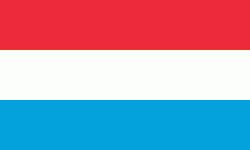Flag of Luxembourg
The national flag of Luxembourg (Lëtzebuerger Fändel; Flagge Luxemburgs; Drapeau du Luxembourg) consists of three horizontal stripes, red, white and light blue, and can be in 1:2 or 3:5 ratio. It was first used between 1845 and 1848 and officially adopted in 1993. It is informally called in the country, «rout, wäiß, blo» ("red, white, [light] blue").
Luxembourg had no flag until 1830, when patriots were urged to display the national colours. The flag was defined as a horizontal tricolour of red, white, and blue in 1848, but it was not officially adopted until 1993. The tricolour flag is almost identical to Flag of the Netherlands, except that it is longer and its light blue stripe and red stripe are a lighter shade. The red, white, and light blue colours were derived from the coat of arms of the House of Luxembourg.
The colours of the flag of Luxembourg were first adopted around 1830 during the Belgian Revolution. They were probably derived from the coat of arms of the County and later Duchy of Luxembourg, which in turn was derived from the combination of the lion of the dukes of Limbourg and the supposed striped banner of the early counts of Luxembourg. The three-coloured horizontal design was fixed on 12 June 1845.
It took until 1993 before a law was passed regulating the flag of Luxembourg. The same law also prescribed ensign and roundel for aircraft and ships registered in Luxembourg.
One important clarification brought by this law was that the color blue was defined as being a very bright blue, in contrast to the flag of the Netherlands (exactly the same design, but the Dutch flag uses dark blue and a less oblong shape).
The heraldic blazon for the flag is per fess Gules and Azure, a fess Argent.
Luxembourg had no flag until 1830, when patriots were urged to display the national colours. The flag was defined as a horizontal tricolour of red, white, and blue in 1848, but it was not officially adopted until 1993. The tricolour flag is almost identical to Flag of the Netherlands, except that it is longer and its light blue stripe and red stripe are a lighter shade. The red, white, and light blue colours were derived from the coat of arms of the House of Luxembourg.
The colours of the flag of Luxembourg were first adopted around 1830 during the Belgian Revolution. They were probably derived from the coat of arms of the County and later Duchy of Luxembourg, which in turn was derived from the combination of the lion of the dukes of Limbourg and the supposed striped banner of the early counts of Luxembourg. The three-coloured horizontal design was fixed on 12 June 1845.
It took until 1993 before a law was passed regulating the flag of Luxembourg. The same law also prescribed ensign and roundel for aircraft and ships registered in Luxembourg.
One important clarification brought by this law was that the color blue was defined as being a very bright blue, in contrast to the flag of the Netherlands (exactly the same design, but the Dutch flag uses dark blue and a less oblong shape).
The heraldic blazon for the flag is per fess Gules and Azure, a fess Argent.
National flag
Country - Luxembourg
Warning: getimagesize(/Image/Map/MP2960313.gif): failed to open stream: No such file or directory in /home/mapnlee7/public_html/MAPNALL/article.php on line 532
 |
 |
With an area of 2,586 km2, Luxembourg is one of the smallest countries in Europe, and the smallest not considered a microstate. In 2022, it had a population of 645,397, which makes it one of the least-populated countries in Europe, albeit with the highest population growth rate; foreigners account for nearly half the population. Luxembourg is a representative democracy headed by a constitutional monarch, Grand Duke Henri, making it the world's only remaining sovereign grand duchy.
